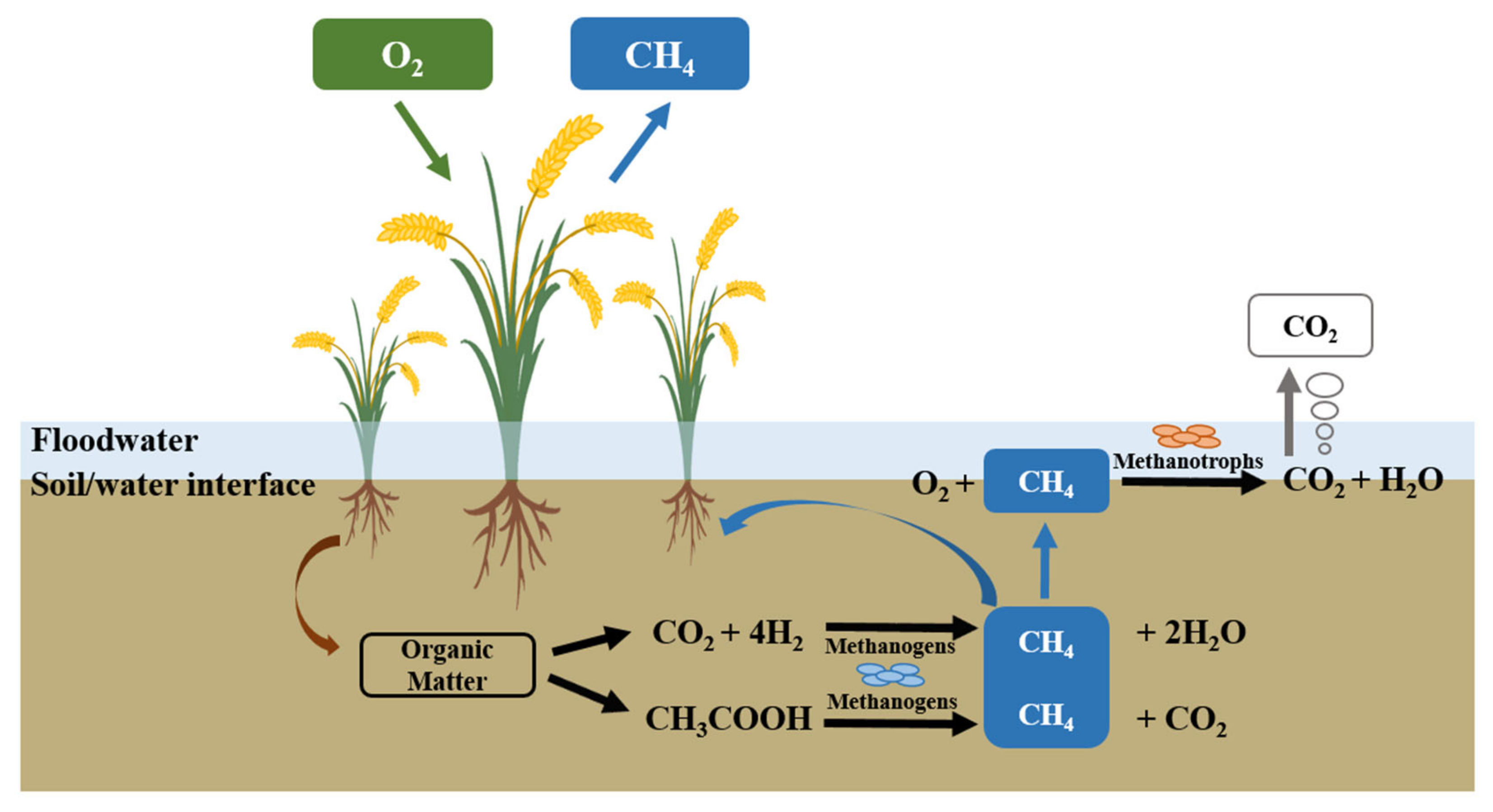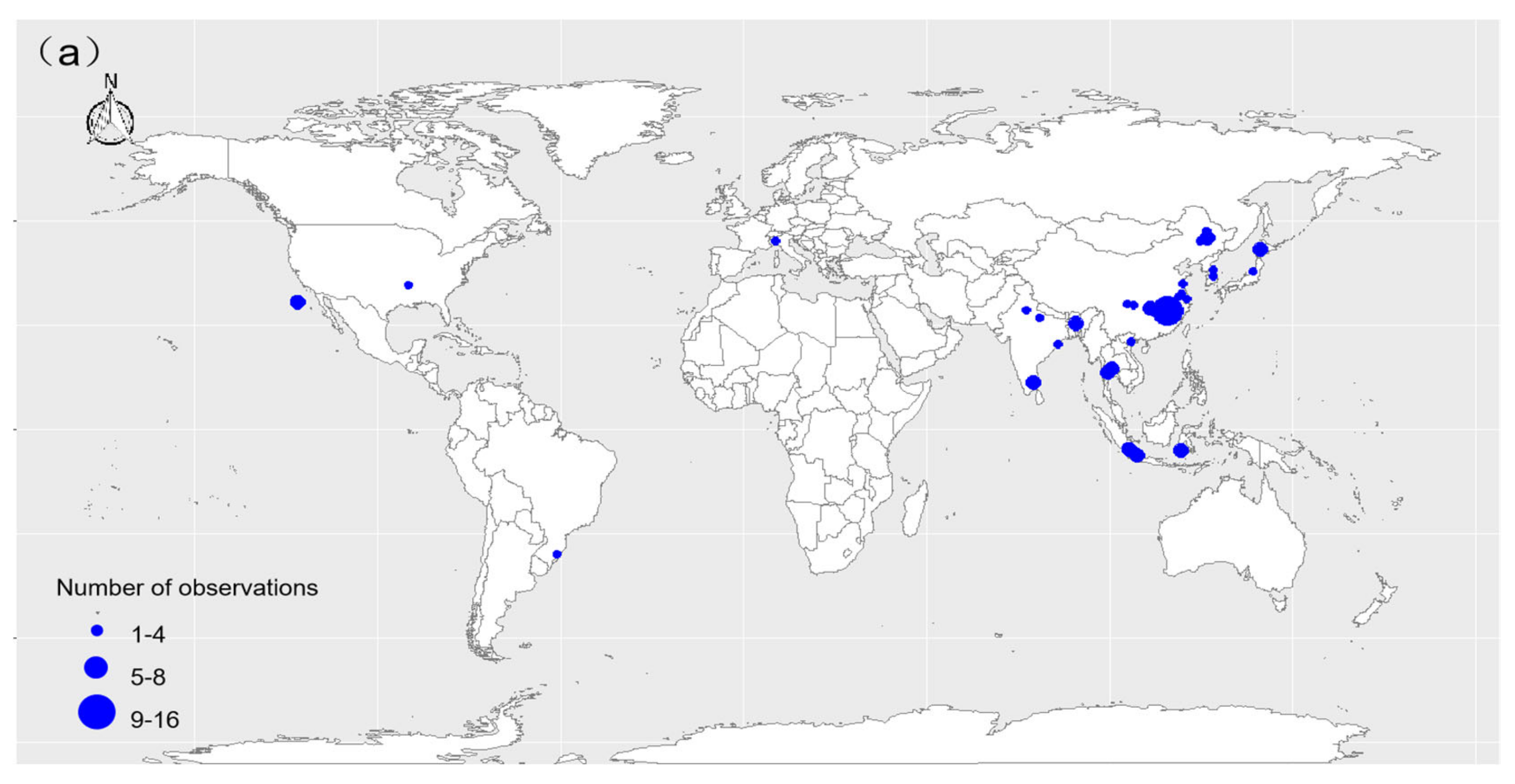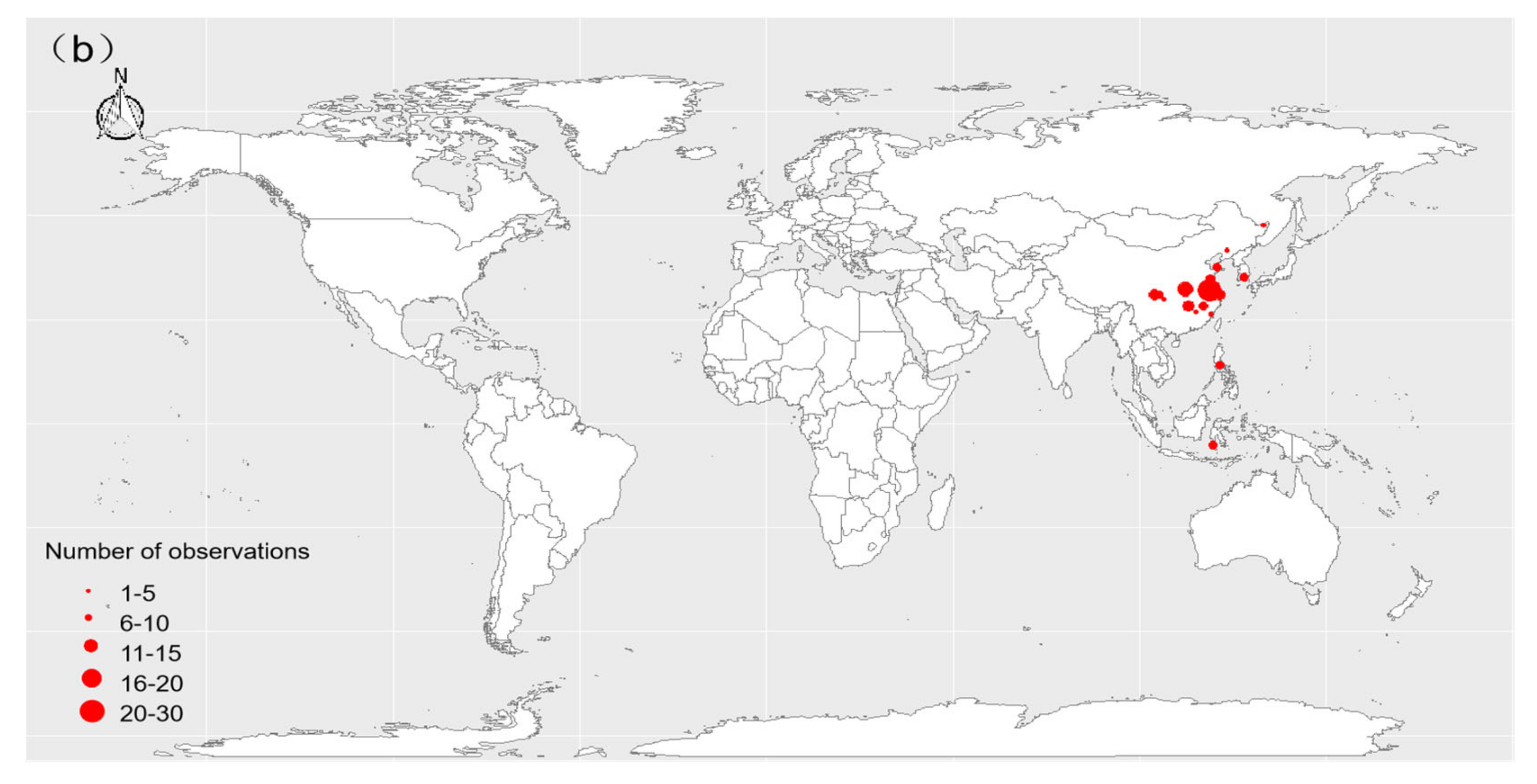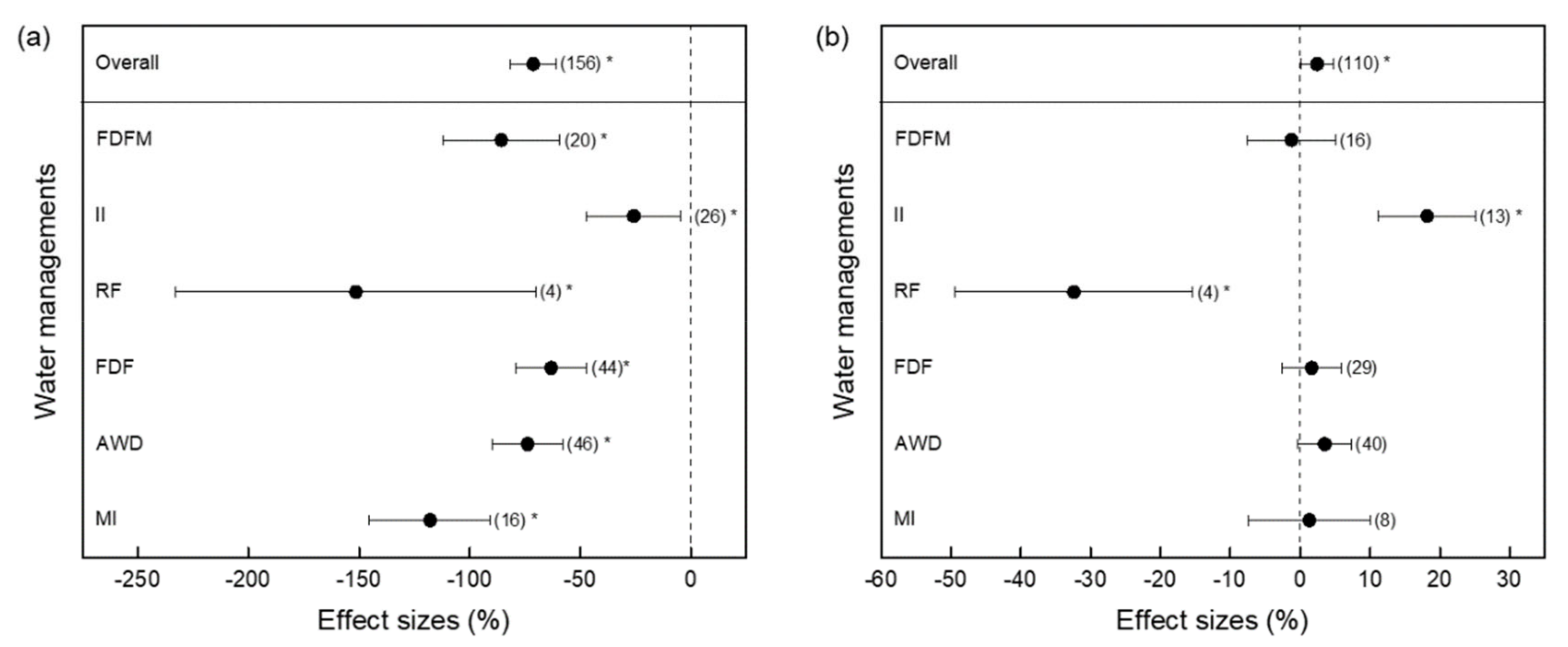Effects of Water and Fertilizer Management Practices on Methane Emissions from Paddy Soils: Synthesis and Perspective
Abstract
:1. Introduction
2. Materials and Methods
2.1. Effects of Water Management on Soil CH4 Emissions and Rice Yield
2.2. Effects of Fertilizer Management on Soil CH4 Emissions and Rice Yield
2.3. Statistical Analysis
3. Results and Discussions
3.1. Impact of Water Management on CH4 Emissions from Paddy Fields and Suitable Management Recommendations
3.2. Impact of Fertilizer Management on CH4 Emissions in Paddy Fields and Suitable Management Recommendations
4. Conclusions and Prospects
4.1. Regulatory Effects of Rice Varieties on Soil CH4 Emissions
4.2. Influence of Soil Food Webs on Soil CH4 Emissions from Paddy Fields
Supplementary Materials
Author Contributions
Funding
Data Availability Statement
Conflicts of Interest
References
- IPCC. Climate Change 2021: The Physical Science Basis; Cambridge University Press: Cambridge, UK, 2021. [Google Scholar]
- Bridgham, S.D.; Cadillo-Quiroz, H.; Keller, J.K.; Zhuang, Q. Methane emissions from wetlands: Biogeochemical, microbial, and modeling perspectives from local to global scales. Glob. Chang. Biol. 2013, 19, 1325–1346. [Google Scholar] [CrossRef] [PubMed]
- Montzka, S.A.; Dlugokencky, E.J.; Butler, J.H. Non-CO2 greenhouse gases and climate change. Nature 2011, 476, 43–50. [Google Scholar] [CrossRef] [PubMed]
- Vermeulen, S.J.; Campbell, B.M.; Ingram, J.S.I. Climate change and food systems. Annu. Rev. Environ. Resour. 2012, 37, 195–222. [Google Scholar] [CrossRef] [Green Version]
- Chen, Y.H.; Prinn, R.G. Estimation of atmospheric methane emissions between 1996 and 2001 using a three-dimensional global chemical transport model. J. Geophys. Res. Atmos. 2006, 111, D10. [Google Scholar] [CrossRef] [Green Version]
- Aselmann, I.; Crutzen, P.J. Global distribution of natural freshwater wetlands and rice paddies, their net primary productivity, seasonality and possible methane emissions. J. Atmos. Chem. 1989, 8, 307–358. [Google Scholar] [CrossRef]
- Yan, X.; Akiyama, H.; Yagi, K.; Akimoto, H. Global estimations of the inventory and mitigation potential of methane emissions from rice cultivation conducted using the 2006 Intergovernmental Panel on Climate Change guidelines. Glob. Biogeochem. Cycles 2009, 23, GB2002. [Google Scholar] [CrossRef]
- Seck, P.A.; Diagne, A.; Mohanty, S.; Wopereis, M.C.S. Crops that feed the world 7: Rice. Food Secur. 2012, 4, 7–24. [Google Scholar] [CrossRef]
- Inubushi, K.; Cheng, W.; Aonuma, S.; Hoque, M.M.; Kobayashi, K.; Miura, S.; Kim, H.Y.; Okada, M. Effects of free-air CO2 enrichment (FACE) on CH4 emission from a rice paddy field. Glob. Chang. Biol. 2003, 9, 1458–1464. [Google Scholar] [CrossRef]
- Van Groenigen, K.J.; van Kessel, C.; Hungate, B.A. Increased greenhouse-gas intensity of rice production under future atmospheric conditions. Nat. Clim. Chang. 2013, 3, 288–291. [Google Scholar] [CrossRef]
- Hillier, J.; Brentrup, F.; Wattenbach, M.; Walter, C.; Garcia-Suarez, T.; Mila-i-Canals, L.; Smith, P. Which cropland greenhouse gas mitigation options give the greatest benefits in different world regions? Climate and soil-specific predictions from integrated empirical models. Glob. Chang. Biol. 2012, 18, 1880–1894. [Google Scholar] [CrossRef]
- Zhang, W.; Sheng, R.; Zhang, M.; Xiong, G.; Hou, H.; Li, S.; Wei, W. Effects of continuous manure application on methanogenic and methanotrophic communities and methane production potentials in rice paddy soil. Agric. Ecosyst. Environ. 2018, 258, 121–128. [Google Scholar] [CrossRef]
- Xu, J.; Jia, Z.; Lin, X.; Feng, Y. DNA-based stable isotope probing identifies formate-metabolizing methanogenic archaea in paddy soil. Microbiol. Res. 2017, 202, 36–42. [Google Scholar] [CrossRef]
- Eller, G.; Krüger, M.; Frenzel, P. Comparing field and microcosm experiments: A case study on methano- and methylo-trophic bacteria in paddy soil. FEMS Microbiol. Ecol. 2005, 51, 279–291. [Google Scholar] [CrossRef] [Green Version]
- Zhang, G.; Zhang, W.; Yu, H.; Ma, J.; Xu, H.; Yagi, K. Fraction of CH4 oxidized in paddy field measured by stable carbon isotopes. Plant Soil 2015, 389, 349–359. [Google Scholar] [CrossRef]
- Wassmann, R.; Lantin, R.S.; Neue, H.U.; Buendia, L.V.; Corton, T.M.; Lu, Y. Characterization of methane emissions from rice fields in Asia. III. Mitigation options and future research needs. Nutr. Cycl. Agroecosys. 2000, 58, 23–36. [Google Scholar] [CrossRef]
- Ni, X.; Groffman, P.M. Declines in methane uptake in forest soils. Proc. Natl. Acad. Sci. USA 2018, 115, 8587–8590. [Google Scholar] [CrossRef] [Green Version]
- Price, S.J.; Sherlock, R.R.; Kelliher, F.M.; McSeveny, T.M.; Tate, K.R.; Condron, L.M. Pristine New Zealand forest soil is a strong methane sink. Glob. Chang. Biol. 2004, 10, 16–26. [Google Scholar] [CrossRef]
- Ma, K.; Conrad, R.; Lu, Y. Responses of methanogen mcrA genes and their transcripts to an alternate dry/wet cycle of paddy field soil. Appl. Environ. Microbiol. 2012, 78, 445–454. [Google Scholar] [CrossRef] [Green Version]
- Zhou, X.; Guo, Z.; Chen, C.; Jia, Z. Soil microbial community structure and diversity are largely influenced by soil pH and nutrient quality in 78-year-old tree plantations. Biogeosciences 2017, 14, 2101–2111. [Google Scholar] [CrossRef] [Green Version]
- Feng, H.; Guo, J.; Han, M.; Wang, W.; Peng, C.; Jin, J.; Song, X.; Yu, S. A review of the mechanisms and controlling factors of methane dynamics in forest ecosystems. For. Ecol. Manag. 2020, 455, 117702. [Google Scholar] [CrossRef]
- Naser, H.M.; Nagata, O.; Tamura, S.; Hatano, R. Methane emissions from five paddy fields with different amounts of rice straw application in central Hokkaido, Japan. Soil Sci. Plant Nutr. 2007, 53, 95–101. [Google Scholar] [CrossRef] [Green Version]
- Yang, S.; Peng, S.; Xu, J.; Luo, Y.; Li, D. Methane and nitrous oxide emissions from paddy field as affected by water-saving irrigation. Phys. Chem. Earth Parts A/B/C 2012, 53–54, 30–37. [Google Scholar] [CrossRef]
- Lee, H.J.; Kim, S.Y.; Kim, P.J.; Madsen, E.L.; Jeon, C.O. Methane emission and dynamics of methanotrophic and methanogenic communities in a flooded rice field ecosystem. FEMS Microbiol. Ecol. 2014, 88, 195–212. [Google Scholar] [CrossRef]
- Towprayoon, S.; Smakgahn, K.; Poonkaew, S. Mitigation of methane and nitrous oxide emissions from drained irrigated rice fields. Chemosphere 2005, 59, 1547–1556. [Google Scholar] [CrossRef]
- Linquist, B.A.; Anders, M.M.; Adviento-Borbe, M.A.A.; Chaney, R.L.; Nalley, L.L.; da Rosa, E.F.F.; van Kessel, C. Reducing greenhouse gas emissions, water use, and grain arsenic levels in rice systems. Glob. Chang. Biol. 2015, 21, 407–417. [Google Scholar] [CrossRef]
- Tariq, A.; Jensen, L.S.; de Tourdonnet, S.; Sander, B.O.; de Neergaard, A. Early drainage mitigates methane and nitrous oxide emissions from organically amended paddy soils. Geoderma 2017, 304, 49–58. [Google Scholar] [CrossRef]
- Jia, Z.; Cai, Z.; Tsuruta, H. Effect of rice cultivar on CH4 production potential of rice soil and CH4 emission in a pot experiment. Soil Sci. Plant Nutr. 2006, 52, 341–348. [Google Scholar] [CrossRef]
- Li, J.; Li, Y.; Wan, Y.; Wang, B.; Waqas, M.A.; Cai, W.; Guo, C.; Zhou, S.; Su, R.; Qin, X.; et al. Combination of modified nitrogen fertilizers and water saving irrigation can reduce greenhouse gas emissions and increase rice yield. Geoderma 2018, 315, 1–10. [Google Scholar] [CrossRef]
- Minamikawa, K.; Fumoto, T.; Iizumi, T.; Cha-un, N.; Pimple, U.; Nishimori, M.; Ishigooka, Y.; Kuwagata, T. Prediction of future methane emission from irrigated rice paddies in central Thailand under different water management practices. Sci. Total Environ. 2016, 566–567, 641–651. [Google Scholar] [CrossRef] [Green Version]
- Jiang, Y.; Carrijo, D.; Huang, S.; Chen, J.; Balaine, N.; Zhang, W.; van Groenigen, K.J.; Linquist, B. Water management to mitigate the global warming potential of rice systems: A global meta-analysis. Field Crops Res. 2019, 234, 47–54. [Google Scholar] [CrossRef]
- Liu, X.; Zhou, T.; Liu, Y.; Zhang, X.; Li, L.; Pan, G. Effect of mid-season drainage on CH4 and N2O emission and grain yield in rice ecosystem: A meta-analysis. Agric. Water Manag. 2019, 213, 1028–1035. [Google Scholar] [CrossRef]
- Islam, S.F.; van Groenigen, J.W.; Jensen, L.S.; Sander, B.O.; de Neergaard, A. The effective mitigation of greenhouse gas emissions from rice paddies without compromising yield by early-season drainage. Sci. Total Environ. 2018, 612, 1329–1339. [Google Scholar] [CrossRef]
- Tariq, A.; Vu, Q.D.; Jensen, L.S.; de Tourdonnet, S.; Sander, B.O.; Wassmann, R.; Van Mai, T.; de Neergaard, A. Mitigating CH4 and N2O emissions from intensive rice production systems in northern Vietnam: Efficiency of drainage patterns in combination with rice residue incorporation. Agric. Ecosyst. Environ. 2017, 249, 101–111. [Google Scholar] [CrossRef]
- Inselsbacher, E.; Wanek, W.; Ripka, K.; Hackl, E.; Sessitsch, A.; Strauss, J.; Zechmeister-Boltenstern, S. Greenhouse gas fluxes respond to different N fertilizer types due to altered plant–soil–microbe interactions. Plant Soil 2011, 343, 17–35. [Google Scholar] [CrossRef]
- Schimel, J. Rice, microbes and methane. Nature 2000, 403, 375–377. [Google Scholar] [CrossRef]
- Pan, N.; Zhang, S.; Xu, J.; Sun, Y.; Tang, J. Effects and countermeasures of straw return on soil environment for crop growth. Shanghai Agric. Sci. Technol. 2010, 2, 22–23. [Google Scholar]
- Xu, H.; Cai, Z.C.; Li, X.P.; Tsuruta, H. Effect of antecedent soil water regime and rice straw application time on CH4 emission from rice cultivation. Soil Res. 2000, 38, 1–12. [Google Scholar] [CrossRef]
- Kim, S.Y.; Pramanik, P.; Kim, P.J. Impact of Methanogens Originated from Cattle Manure on Increasing CH4 Emission in Paddy Soil during Rice Cultivation; Springer: Dordrecht, The Netherlands, 2013; pp. 877–880. [Google Scholar]
- Zhou, B.; Wang, Y.; Feng, Y.; Lin, X. The application of rapidly composted manure decreases paddy CH4 emission by adversely influencing methanogenic archaeal community: A greenhouse study. J. Soils Sed. 2016, 16, 1889–1900. [Google Scholar] [CrossRef]
- Zheng, Y.; Zhang, L.-M.; Zheng, Y.-M.; Di, H.; He, J.-Z. Abundance and community composition of methanotrophs in a Chinese paddy soil under long-term fertilization practices. J. Soils Sed. 2008, 8, 406–414. [Google Scholar] [CrossRef] [Green Version]
- Zhou, W.; Lou, Y.; Ren, L.; Han, Y.; Meng, Y.; Wu, L. Application of controlled-release nitrogen fertilizer decreased methane emission in transgenic rice from a paddy soil. Water Air Soil Pollut. 2014, 225, 1897. [Google Scholar]
- Anitha, K.; Bindu, G. Effect of controlled-release nitrogen fertilizer on methane emission from paddy field soil. Procedia Technol. 2016, 24, 196–202. [Google Scholar] [CrossRef]
- Shakoor, A.; Xu, Y.; Wang, Q.; Chen, N.; He, F.; Zuo, H.; Yin, H.; Yan, X.; Ma, Y.; Yang, S. Effects of fertilizer application schemes and soil environmental factors on nitrous oxide emission fluxes in a rice–wheat cropping system, east China. PLoS ONE 2018, 13, e0202016. [Google Scholar] [CrossRef] [PubMed]
- Bodelier, P.L.E.; Laanbroek, H.J. Nitrogen as a regulatory factor of methane oxidation in soils and sediments. FEMS Microbiol. Ecol. 2004, 47, 265–277. [Google Scholar] [CrossRef]
- Yuan, J.; Yuan, Y.; Zhu, Y.; Cao, L. Effects of different fertilizers on methane emissions and methanogenic community structures in paddy rhizosphere soil. Sci. Total Environ. 2018, 627, 770–781. [Google Scholar] [CrossRef] [PubMed]
- Pan, D.D.; Wu, X.W.; Tian, G.M.; He, M.M.; Mahmood, Q.; Yao, J.H. CO2 and CH4 fluxes from a plant-soil ecosystem after organic compost and inorganic fertilizer applications to Brassica chinensis. J. Food Agric. Environ. 2012, 10, 1240–1245. [Google Scholar]
- Zhang, G.; Ji, Y.; Ma, J.; Xu, H.; Cai, Z.; Yagi, K. Intermittent irrigation changes production, oxidation, and emission of CH4 in paddy fields determined with stable carbon isotope technique. Soil Biol. Biochem. 2012, 52, 108–116. [Google Scholar] [CrossRef]
- Begum, K.; Kuhnert, M.; Yeluripati, J.B.; Ogle, S.M.; Parton, W.J.; Williams, S.A.; Pan, G.; Cheng, K.; Ali, M.A.; Smith, P. Modelling greenhouse gas emissions and mitigation potentials in fertilized paddy rice fields in Bangladesh. Geoderma 2019, 341, 206–215. [Google Scholar] [CrossRef] [Green Version]
- Gutierrez, J.; Kim, S.Y.; Kim, P.J. Effect of rice cultivar on CH4 emissions and productivity in Korean paddy soil. Field Crops Res. 2013, 146, 16–24. [Google Scholar] [CrossRef]
- Zou, J.; Huang, Y.; Jiang, J.; Zheng, X.; Sass, R.L. A 3-year field measurement of methane and nitrous oxide emissions from rice paddies in China: Effects of water regime, crop residue, and fertilizer application. Glob. Biogeochem. Cycles 2005, 19, GB2021. [Google Scholar] [CrossRef]
- Aulakh, M.S.; Wassmann, R.; Rennenberg, H. Methane transport capacity of twenty-two rice cultivars from five major Asian rice-growing countries. Agric. Ecosyst. Environ. 2002, 91, 59–71. [Google Scholar] [CrossRef]
- Kerdchoechuen, O. Methane emission in four rice varieties as related to sugars and organic acids of roots and root exudates and biomass yield. Agric. Ecosyst. Environ. 2005, 108, 155–163. [Google Scholar] [CrossRef]
- Bloom, A.; Swisher, M. Emissions from Rice Production. In: Encyclopedia of Earth. 2010. Available online: http://www.eoearth.org/article/Emissions_from_Rice_Production?topic=54486 (accessed on 15 June 2011).
- Gu, X.; Zhou, X.; Bu, X.; Xue, M.; Jiang, L.; Wang, S.; Hao, Y.; Wang, Y.; Xu, X.; Wang, G.; et al. Soil extractable organic C and N contents, methanotrophic activity under warming and degradation in a Tibetan alpine meadow. Agric. Ecosyst. Environ. 2019, 278, 6–14. [Google Scholar] [CrossRef]
- Bu, X.; Gu, X.; Zhou, X.; Zhang, M.; Guo, Z.; Zhang, J.; Zhou, X.; Chen, X.; Wang, X. Extreme drought slightly decreased soil labile organic C and N contents and altered microbial community structure in a subtropical evergreen forest. For. Ecol. Manag. 2018, 429, 18–27. [Google Scholar] [CrossRef]
- Hernandez, M.E.; Beck, D.A.C.; Lidstrom, M.E.; Chistoserdova, L. Oxygen availability is a major factor in determining the composition of microbial communities involved in methane oxidation. PeerJ 2015, 3, e801. [Google Scholar] [CrossRef]
- Conrad, R. Microbial ecology of methanogens and methanotrophs. Adv. Agron. 2007, 96, 1–63. [Google Scholar]
- Semrau, J.D.; DiSpirito, A.A.; Gu, W.; Yoon, S.; Cann, I. Metals and methanotrophy. Appl. Environ. Microbiol. 2018, 84, e02289-17. [Google Scholar] [CrossRef] [Green Version]
- Devlin, S.P.; Saarenheimo, J.; Syväranta, J.; Jones, R.I. Top consumer abundance influences lake methane efflux. Nat. Commun. 2015, 6, 8787. [Google Scholar] [CrossRef] [Green Version]
- Arjen de Groot, G.; Laros, I.; Geisen, S. Molecular identification of soil eukaryotes and focused approaches targeting protist and faunal groups using high-throughput metabarcoding. In Microbial Environmental Genomics (MEG); Martin, F., Uroz, S., Eds.; Springer: New York, NY, USA, 2016; pp. 125–140. [Google Scholar]
- Sherr, E.B.; Sherr, B.F. Food webs, microbial. In Encyclopedia of Microbiology, 3rd ed.; Academic Press: Cambridge, MA, USA, 2009; pp. 174–189. [Google Scholar]
- Reim, A.; Lüke, C.; Krause, S.; Pratscher, J.; Frenzel, P. One millimetre makes the difference: High-resolution analysis of methane-oxidizing bacteria and their specific activity at the oxic–anoxic interface in a flooded paddy soil. ISME J. 2012, 6, 2128–2139. [Google Scholar] [CrossRef]
- Segers, R. Methane production and methane consumption: A review of processes underlying wetland methane fluxes. Biogeochemistry 1998, 41, 23–51. [Google Scholar] [CrossRef]
- Murase, J.; Frenzel, P. Selective grazing of methanotrophs by protozoa in a rice field soil. FEMS Microbiol. Ecol. 2008, 65, 408–414. [Google Scholar] [CrossRef] [Green Version]





Publisher’s Note: MDPI stays neutral with regard to jurisdictional claims in published maps and institutional affiliations. |
© 2022 by the authors. Licensee MDPI, Basel, Switzerland. This article is an open access article distributed under the terms and conditions of the Creative Commons Attribution (CC BY) license (https://creativecommons.org/licenses/by/4.0/).
Share and Cite
Gu, X.; Weng, S.; Li, Y.; Zhou, X. Effects of Water and Fertilizer Management Practices on Methane Emissions from Paddy Soils: Synthesis and Perspective. Int. J. Environ. Res. Public Health 2022, 19, 7324. https://doi.org/10.3390/ijerph19127324
Gu X, Weng S, Li Y, Zhou X. Effects of Water and Fertilizer Management Practices on Methane Emissions from Paddy Soils: Synthesis and Perspective. International Journal of Environmental Research and Public Health. 2022; 19(12):7324. https://doi.org/10.3390/ijerph19127324
Chicago/Turabian StyleGu, Xinyun, Shimei Weng, Yu’e Li, and Xiaoqi Zhou. 2022. "Effects of Water and Fertilizer Management Practices on Methane Emissions from Paddy Soils: Synthesis and Perspective" International Journal of Environmental Research and Public Health 19, no. 12: 7324. https://doi.org/10.3390/ijerph19127324
APA StyleGu, X., Weng, S., Li, Y., & Zhou, X. (2022). Effects of Water and Fertilizer Management Practices on Methane Emissions from Paddy Soils: Synthesis and Perspective. International Journal of Environmental Research and Public Health, 19(12), 7324. https://doi.org/10.3390/ijerph19127324





